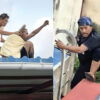Although airports have witnessed an uptick in cases, ports have experienced the greatest increase. Traffickers know that workers at airports have had special training on how to spot and respond to trafficking situations, but many port workers have received little or no training. There is a gap in the net, and it is being exploited.

It is time for port officials to take this problem seriously by offering training. Port workers must learn to spot the red flags. Use the following list as the start of awareness of human trafficking.
Does a child avoid eye contact and refuse to answer questions? To an extent, many children suffer from shyness around strangers, so rather than calling the police when a child hides behinds his mother’s leg, maybe we could look for other signs first.
Is a person travelling alone and does not know their destination, or the name of the person they are travelling with? Lack of specific information if a giveaway that something is wrong. People may be reluctant to share this information with strangers but should be comfortable telling it to official personnel like port officials or ship’s crew. If not, something is fishy.
Do they have a ravenous appetite, like they have not eaten in a long time? Starvation is a common form of control in trafficking situations. Traffickers use access to food as a reward for cooperation. If a child devours a meal when it is put down, as if they have not eaten in days, it is time to pay attention.
Does a person book a lot of hotel rooms and always pay in cash? Not that everyone who pays in cash is shady. I often do so myself. But repeated use of large amounts of cash indicates someone who does not want to leave a paper trail. Genuine business travelers need receipts and other paperwork, and often have a credit card connected to an expense account.
Does the person show signs of physical abuse, such as bruises and cuts, and cannot explain how they got them? This is pretty obvious. A badly beaten child or woman may be a victim of trafficking, or at least needs a new home.
Is the person not allowed to speak for themselves, but someone else always answers questions for them? Traffickers try to do all the talking for the person they are moving. If you ask a child or woman a series of questions, even harmless ones, and a third party constantly pipes in to answer it is suspicious.
Is the person in possession of their own paperwork, passport, ticket, ID and so on, or does someone else always carry these things for them? Again, many parents carry these items for their children just so they don’t get lost, so don’t overreact here.
Is the person travelling with few or no personal possessions? I understand minimizing your luggage, but if the person has nothing, no clothes, no book to read, nothing, it is suspicious. Who goes to another country for a week and only brings the clothes on their back?
If the person does not speak the local language, does a third party insist on being present to interpret, even if you have your own translator? Another way to make sure they don’t say anything. The trafficker will always insist on being present and translate himself.
These are simple tips that may help identify a trafficking situation. Pay attention. The life you save may be someone you love.
BC Cook, PhD lived on Saipan and has taught history for 20 years. He travels the Pacific but currently resides on the mainland U.S.











